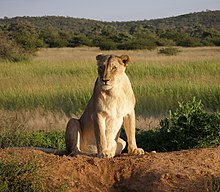
Back Алым Abkhazian Аслъан ADY Leeu Afrikaans Löwe ALS Арслан ALT አንበሳ Amharic Panthera leo AN Lēo ANG सिंह ANP أسد Arabic
| Lion Temporal range:
| |
|---|---|

| |
| Male lion in Okonjima, Namibia | |

| |
| Female (lioness) in Okonjima | |
| Scientific classification | |
| Domain: | Eukaryota |
| Kingdom: | Animalia |
| Phylum: | Chordata |
| Class: | Mammalia |
| Order: | Carnivora |
| Suborder: | Feliformia |
| Family: | Felidae |
| Subfamily: | Pantherinae |
| Genus: | Panthera |
| Species: | P. leo[1]
|
| Binomial name | |
| Panthera leo[1] | |
| Subspecies | |

| |
| Historical and present distribution of the lion in Africa, Asia and Europe | |

The lion (Panthera leo) is a large mammal of the Felidae (cat) family. Some large males weigh over 250 kg (550 lb).[3] Today, wild lions live in sub-Saharan Africa and western India.[4] Lions are adapted for life in grasslands and mixed areas with trees and grass. The relatively small females are fast runners over short distances, and coordinate their hunting of herd animals.
Lions have disappeared from North Africa and southwest Asia in historic times. Until the late Pleistocene, about 10,000 years ago, the lion was the most widespread large land mammal after humans. They were found in most of Africa, across Eurasia from western Europe to India, and in the Americas from the Yukon to Peru.[5] The lion is now a vulnerable species. There was a decline in its African range of 30–50% over two decades in the second half of the 20th century.[2] Habitat loss and conflicts with humans are the greatest causes of concern.
Lions are often called the "king of the beasts". They are used as symbols representing courage. They appear in heraldry more often than any other animal. They are an icon of courage and royalty.
Lions live for 10 to 14 years in the wild. When they are captured, they can live longer than 20 years. In the wild, males do not usually live longer than 10 years. This is because wounds from fighting other males make their lives shorter.[6] They usually live in savanna and grassland. These areas do have bushes and trees, but lions are mainly adapted to catch prey in grasslands. Compared to other cats, lions are social. A group of lions is called a pride. In a pride of lions, there are related females, their young, and one or two adult males. Groups of female lions often hunt together.
Lions are carnivores and scavengers.[7] They are also apex predators.[8] Lions feed ungulates on small feed Thomson's gazelle, springbok, impala, gemsbok, plains zebras, elands, kudu, nyala, warthogs, bushpig, blesbok, hartebeest, blue wildebeest, sable antelope, common tsessebe, waterbuck, lechwe, kob, while take down larger giraffes, and african buffalos, India to then kills deers, nilgais, and adult grown elephants, hippopotamus, rhinoceros, small like dik dik, hyraxs, hares, and monkeys, attacks group baboons, unusual prey include brush porcupines, the young African bush elephant up to around 15 years old in exceptional then take is dangerous reptile crocodiles, cases. Lions scavenge animals either dead from natural causes (disease) or killed by other predators. They keep a constant lookout for circling vultures, because this means there is a dead or injured animal close by.[7]
- ↑ Wozencraft, W.C. (2005). "Species Panthera leo". In Wilson, D.E.; Reeder, D.M (eds.). Mammal Species of the World: A Taxonomic and Geographic Reference (3rd ed.). Johns Hopkins University Press. p. 546. ISBN 978-0-8018-8221-0. OCLC 62265494.
- ↑ 2.0 2.1 Bauer, H.; Packer, C.; Funston, P. F.; Henschel, P. & Nowell, K. (2017) [2016]. "Panthera leo". IUCN Red List of Threatened Species. 2017: e.T15951A115130419.
- ↑ Cite error: The named reference
nowakwas used but no text was provided for refs named (see the help page). - ↑ A few endangered lions live in Gir Forest National Park in India
- ↑ Harington, CR ‘Dick’ (1969). Pleistocene remains of the lion-like cat (Panthera atrox) from the Yukon Territory and northern Alaska. Canadian Journal of Earth Sciences 6 (5): 1277–88. [1]
- ↑ Smuts, G.L. (1982). Lion. Johannesburg: Macmillian. p. 231. ISBN 0-86954-122-6.
- ↑ 7.0 7.1 Schaller, George B. 1972. The Serengeti lion: a study of predator–prey relations. Chicago: University of Chicago Press, p. 213.. ISBN 0-226-73639-3
- ↑ >"Behavior and Diet". African Wildlife Foundation website. African Wildlife Foundation. 1996. Retrieved 14 June 2015.
© MMXXIII Rich X Search. We shall prevail. All rights reserved. Rich X Search
